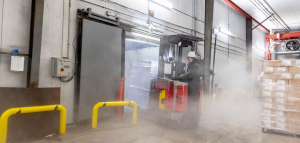How do cold storage warehouses work?
Introduction
How do cold storage warehouses work? Cold storage warehouses are an essential component of the supply chain for many industries, including food and beverage, pharmaceuticals, and biotech. These facilities provide a controlled environment for the storage of temperature-sensitive products, ensuring that they maintain their quality and integrity until they reach their intended destination. In this article, we will explore the inner workings of cold storage warehouses and how they maintain the necessary temperature and humidity levels to protect their contents.
The Purpose of Cold Storage Warehouses
The primary function of cold storage warehouses is to preserve the quality of perishable products by maintaining the appropriate temperature and humidity levels. These facilities typically store products at temperatures ranging from -20 to 55 degrees Celsius (-4 to 131 degrees Fahrenheit), depending on the specific needs of the products being stored. In addition to temperature control, cold storage warehouses also regulate humidity levels to prevent moisture damage or freezer burn.
Refrigeration Systems
To maintain the required temperature and humidity levels, cold storage warehouses use advanced refrigeration systems that can maintain a consistent environment throughout the facility. The most common type of refrigeration system used in cold storage facilities is the vapor compression refrigeration system, which uses a refrigerant to absorb heat from the air and transfer it to a condenser where it is released. This process creates a cycle of refrigeration that cools the air inside the facility.
Insulation
In addition to refrigeration systems, cold storage warehouses also rely heavily on insulation to maintain a consistent environment. Insulation helps to prevent the transfer of heat and cold from outside the facility, which can cause temperature fluctuations and compromise the quality of the products being stored. Common insulation materials used in cold storage warehouses include foam, fiberglass, and cellulose.

Temperature Monitoring and Control
To ensure that the temperature and humidity levels are maintained within the appropriate range, cold storage warehouses rely on advanced monitoring and control systems. These systems use sensors and software to track temperature and humidity levels throughout the facility and make adjustments as needed to maintain a consistent environment. In the event of a power outage or other disruption, backup systems are in place to ensure that the environment remains stable.
Storage Methods
In addition to temperature and humidity control, cold storage warehouses also use specialized storage methods to protect their contents. These methods are designed to prevent contamination, freezer burn, and other issues that can compromise the quality of the products being stored.
Pallet Racking
One of the most common storage methods used in cold storage warehouses is pallet racking. This method involves stacking pallets of products on shelves, which are designed to maximize storage capacity while minimizing the risk of contamination. Pallet racking systems can be configured in a variety of ways to accommodate products of different shapes and sizes.
Bulk Storage
Bulk storage is another common method used in cold storage facilities. This method involves storing large quantities of products in large, insulated containers, which are designed to maintain a consistent temperature and humidity level. Bulk storage is often used for products that are not easily stackable or are too large for pallet racking.
Automated Storage and Retrieval Systems
Automated storage and retrieval systems are becoming increasingly popular in cold storage warehouses. These systems use advanced robotics and software to manage the movement of products throughout the facility, which can improve efficiency and reduce the risk of human error. Automated storage and retrieval systems can also reduce the risk of contamination by minimizing the need for human interaction with the products being stored.

Conclusion
Cold storage warehouses play a critical role in the supply chain for temperature-sensitive products. By using advanced refrigeration systems, insulation, temperature monitoring and control, and specialized storage methods, these facilities can ensure that their contents remain at the appropriate temperature and humidity levels, protecting their quality and integrity until they reach their destination. As technology continues to advance, cold storage warehouses will undoubtedly continue to evolve, providing even more advanced solutions for the storage and transportation of temperature-sensitive products. For more information click here

Recent Comments